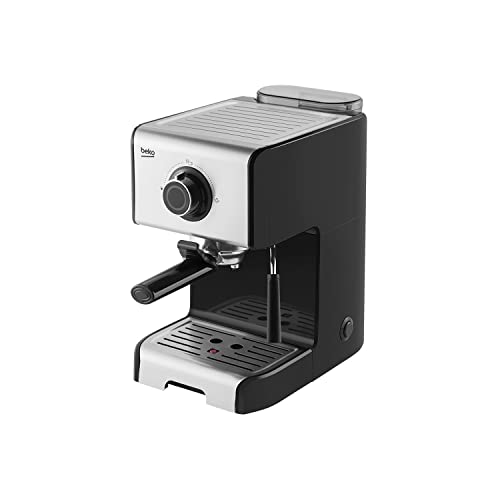What to Look For in a Commercial Espresso Machine
When you purchase a commercial espresso machine, there are a number of aspects to take into consideration. The kind of espresso machine that is suitable for your cafe will depend on the amount and purpose of use and the barista's skill.
Double boilers provide the ability to brew as well as steam simultaneously. It also speeds up the recovery time between pulls. Proportional-integral-derivative (PID) temperature control manages on/off cycles for optimal boiler temperatures.

Productivity
A commercial espresso machine is designed to handle a more volume of coffee than a home espresso machine. If you expect a home espresso maker to function in a professional setting would be an unintentional recipe for disaster.
A commercial machine that is of high quality will be able serve up to 100 coffee cups per hour at peak times. This is a great benefit for busy workplaces, stopping employees from waiting for hours to get their coffee.
Coffee machines can aid in bonding between workers. Teams of people usually take turns getting coffee for one another, which can promote collaboration and teamwork in the workplace. Having a dedicated space for coffee can aid new employees in feeling at comfortably in the workplace, breaking down any barriers between them and senior staff members.
Commercial espresso machines are available in various sizes to meet a variety of needs. Certain models are fully automated and others are able to pre-program espresso sizes so that baristas aren't required to guess the correct size. This is especially important for companies with untrained baristas, since inaccurate shots can greatly impact the flavor and intensity of brewed espresso. In addition, it's ideal to purchase ethically sourced and commercial espresso machines which support the communities where coffee is produced. This will ensure that the product is of top quality and minimizes the negative impact on the environment.
Safety
Espresso machines are big, heavy pieces of equipment that can cost the same as a brand new compact car. They are designed to produce hundreds of shots and drinks in a single day. These high volume operations can create some unique work safety and health risks for employees, which is why it's important to consider the risks that could be associated with an espresso machine in a commercial setting.
Keep in mind that commercial espresso machines are likely to utilize warm water. This could encourage the growth of bacteria. Poorly maintained machines that are not regularly cleaned and descaled can accumulate spent espresso. This could cause it to turn rancid and may cause illness if consumed by customers. Commercial espresso machines with a steam wand that is not sealed may allow bacteria to flourish in the milk foaming process.
Take into consideration the type of beverage you'll serve and the number of cups an hour of your space can hold when selecting a commercial-grade coffee machine. You'll also want to find machines that have automation features, which make it much easier and quicker to serve your customers your favorite coffee drink. In espresso makers , you should look for a guarantee that covers parts and labor to ensure that any technical issues are addressed quickly and effectively.
Energy Efficiency
The power requirements for commercial espresso machines are much greater than home models. Professional espresso machines weigh more and have larger capacity boilers in order to support several group heads for normal cafe production. These machines also operate at a much greater temperature at ambient temperatures and are typically located in an indoor location (such as a coffee shop or restaurant) where the electronic components can overheat quickly resulting in malfunctioning machines.
The boiler of commercial espresso machines heats and holds pressurized drinking water supplied by an electric pump. The water is used to brew and steam espresso. The boiler is made up of a number of copper tubes that are heated by electric elements. If the brew sensor detects that the water level has reached the desired level the solenoid valve is opened and the boiler is filled with fresh water. The heating element is then shut off.
There are four variants of espresso machines, differentiated by their ability to brew and steam the water: TB (brewing only), TX (twin boilers), HX, and DA (double automatic). TB and TX machines ensure stable brewing temperatures, while DA provides rapid steaming with only one boiler. HX machines are utilized by many cafes since they provide the highest quality in steam and brew temperature.
Maintenance
Just like cars need routine tune-ups commercial espresso machines need maintenance to continue working smoothly and efficiently. If you keep your machine in good condition it will provide you with a more delicious coffee and it will last longer.
Cleaning your espresso machine is an everyday practice, but it's crucial to clean your machine on a greater scale. There's likely to be residue of coffee grounds and milk products in the machine which could break down various components over time. Regular cleaning can prevent this from happening and helps keep your espresso machine working at optimally.
Most commercial espresso machines require descaling every three months. This process requires additional steps over regular cleaning, so it's best to read the manual to ensure you're following the instructions. The solution used for descaling the water tank disintegrates the scale. You'll need a container in order to finish this task. In certain units there may be a container beneath the coffee spouts. Follow the directions for your specific model.
Another important maintenance step is to change the water filters. This is something that could easily be forgotten however it's essential to keep in mind so you don't end up with a build-up of mineral deposits. It is also important to look for calcification within the spray head, which is difficult to get rid of.
